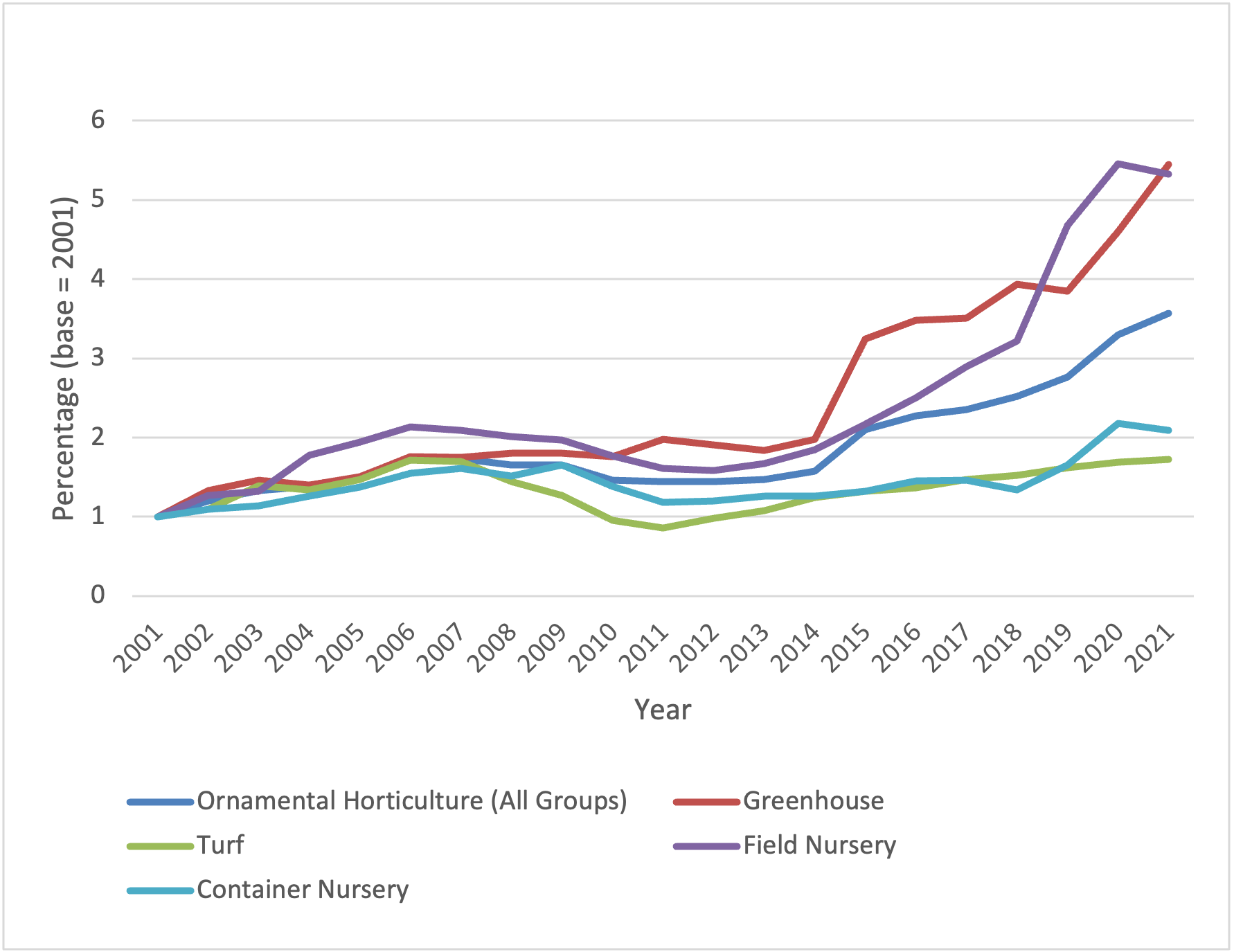Main Takeaways
- 2023 was a good year for many green industry firms, but not as good as 2020–2022.
- There are many unknowns going into 2024 that will impact green industry sales, including higher inflation and interest rates, mixed signals within the economy, increased input costs, and the impact of the varying strength of the housing market in Georgia.
- Green industry sales in Georgia are projected to be lower than 2023 levels.
The green industry—the production, distribution, retailing, and services associated with ornamental plants; landscape and garden supplies; and nursery, greenhouse, and sod growers—is highly dependent on the overall national and local economies. In 2018, the last year estimates were calculated, the Georgia green industry was ranked as the 10th largest across all states in the U.S. with a regional economic impact of $9.97 billion with employment at around 100,000 (both direct and indirect; Campbell & Khachatryan, 2020). Overall, in 2021 the Georgia green industry had $1.2 billion in farm gate sales, which rank the green industry as the second largest agricultural commodity in the state only behind broilers. Notably, the greenhouse segment is the largest sector (ranking sixth in agricultural farm gate value at approximately $636 million in 2021), followed by container nursery (ranked 16th with around $212 million in farm gate sales), field nursery (17th with around $196 million in farm gate sales), and turfgrass (22nd with $126 million in farm gate sales; University of Georgia Center for Agribusiness and Economic Development Farm Gate Value Report, 2022).
Coming off of strong 2020 demand and sales, many firms increased supply in anticipation of strong demand in 2021. However, 2021 saw a decrease or stagnant demand (Figure 1). This does not mean firms were less profitable, interest in purchasing increased, especially in the greenhouse sector, coming from low interest rates leading to a strong housing market in many areas.

*Values represent percent changes in farm gate value adjusted to 2001 dollar values. Data comes from the Georgia Farm Gate Value Report developed by the University of Georgia Department of Agricultural and Applied Economics Center for Agribusiness and Economic Development.
The overall economy is an indicator of green industry growth. Forecasting the 2024 season is extremely complex given the number of unknowns in the economy. Economic indicators provide an idea of what 2024 will bring, but there are mixed signals in the marketplace.
Interest rates have risen to 2008 levels, which has cooled housing markets and home renovations in many areas. However, the combination of increased inflation, supply chain issues, and the perceptions of a weaker economic outlook may fuel reduced green industry expenditures. As prices increase, this should be worrisome for green industry firms, as prices are the largest driver of purchasing of many plants, though own-price (a measure of the impact of a changing a products price on quantity demanded of that product) and income (a measure of the impact of changing income on the quantity demanded of that product) are somewhat variable between plants (Abdelmagid et al., 2016; Hovhannisyan & Khachatryan, 2016). For instance, ornamental plants are mostly price elastic (price changes have a large impact on quantity demanded), with foliage plants being more responsive to price changes compared to other plant categories (Hovhannisyan & Khachatryan, 2016).
Another large driver of green industry product demand is the weather. Lower minimum air temperatures during the spring have been shown to increase sales of both herbs and vegetables (as well as flowering annuals, while increased air temperatures increased sales). Notably, a one-unit increase in maximum air temperature resulted in a 9% increase in herbs/vegetable plant sales, while a one-unit decrease in minimum air temperature resulted in a 6% decrease in sales. However, the impact on flowering annuals was larger with a one-unit increase in maximum air temperature resulting in a 19% increase in sales with a one-unit decrease in minimum air temperature resulting in a 14% decrease in flowering annual sales (Behe et al., 2012). National Weather Service projections for the winter of 2023–24 indicate wetter, warmer temperatures for Georgia. During the main growing and purchasing seasons (spring and summer), the industry should expect above average temperatures but increased precipitation across Georgia due to El Niño conditions.
Furthermore, political issues will potentially impact economic growth, as presidential election years generally result in slower economic growth. Slower growth is due to increased nervousness in the stock markets, which is due to not knowing which party will win the presidential election. Economic markets like stability, but major election years cause instability due to not know which administration will win.
Final forecasts for 2024 should take all of the above information into consideration. Most likely there will be slowed green industry growth in 2024 compared to 2023. Given the uncertainty in the economy and many consumers having made big purchases in 2020 and 2021, demand for green industry products will most likely not exceed 2023 levels.
References
Abdelmagid, B. D , Wohlgenant, M. K., & Safley, C. D. (2016). Demand for plants sold in North Carolina garden centers. Agricultural and Resource Economics Review, 25(1), 28–37. https://doi.org/10.1017/S1068280500000046
Behe, B. K., Getter, K. L., & Yue, C. (2012). Should you blame the weather? The influence of weather parameters, month, day of the week on spring herbaceous plant sales in the U.S. Midwest. HortScience, 47(1), 71–73. https://doi.org/10.21273/HORTSCI.47.1.71
Campbell, B. L., & Khachatryan, H. (2020). Economic impact of the Georgia green industry, 2018 (Publication No. AGECON-20-04-PR). https://agecon.uga.edu/content/dam/caes-subsite/ag-econ/documents/extension/publications/Sept%204%20Economic%20Impact%20of%20the%20Georgia%20Green%20Industry%20-%20Economic%20Impact%20Final%20aug%2028%202020%20FINAL.pdf
Hovhannisyan, V., & Khachatryan, H. (2016). Ornamental plants in the United States: An econometric analysis of a household-level demand system. Agribusiness: An International Journal, 33(2), 226–241. https://doi.org/10.1002/agr.21488
University of Georgia Center for Agribusiness and Economic Development. 2022. Georgia Farm Gate Value Report 2021 (Report No. AR-22-01). https://caed.uga.edu/content/dam/caes-subsite/caed/publications/annual-reports-farm-gate-value-reports/2021_GeorgiaFGVReportDec2022%20(1).pdf
Status and Revision History
In Review on Jan 19, 2024
Published on Jan 22, 2024


























































